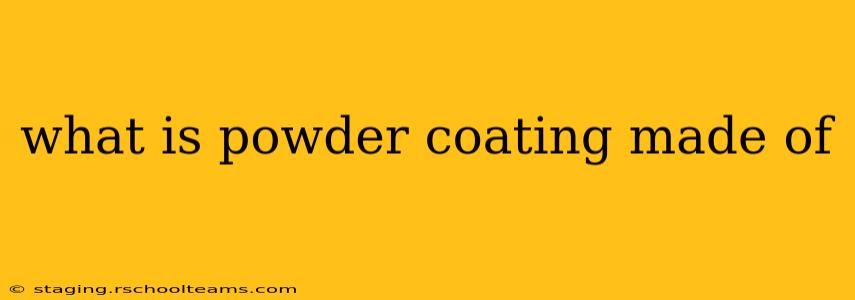Powder coating is a durable and attractive finish used on a wide variety of surfaces, from bicycles to appliances to automotive parts. But what exactly is it made of? Understanding the composition of powder coating is key to appreciating its versatility and performance. This article will explore the ingredients, the application process, and answer some frequently asked questions about this popular coating.
What are the Main Components of Powder Coating?
Powder coating isn't a single substance; it's a complex blend of several key components, each playing a crucial role in the final product's properties. These include:
-
Resin: This forms the base of the powder coating and determines many of its key characteristics, such as flexibility, hardness, and chemical resistance. Common resin types include polyester, epoxy, polyurethane, and hybrid blends. The choice of resin dictates the final coating's suitability for specific applications and environmental conditions.
-
Pigments: These provide the color and aesthetic appeal of the powder coating. A wide range of pigments, both organic and inorganic, are available, allowing for virtually limitless color options. Pigments also contribute to UV resistance and other performance attributes.
-
Curing Agents: These are essential for the curing process. When heated, curing agents react with the resin to create a cross-linked polymer network, transforming the powder into a hard, durable coating. Different curing agents are used depending on the resin type and desired properties.
-
Additives: Various additives are often included to enhance specific properties of the powder coating. These can include:
- Flow agents: Improve the evenness of the coating during application.
- Leveling agents: Reduce surface imperfections and create a smoother finish.
- UV stabilizers: Enhance resistance to fading and degradation from sunlight.
- Antioxidants: Protect the coating from oxidation and degradation.
What Type of Resin is Used in Powder Coating?
The type of resin used significantly impacts the powder coating's final properties. Let's explore some common types:
-
Polyester: Known for its excellent weatherability, UV resistance, and color retention. It's a popular choice for outdoor applications.
-
Epoxy: Offers good chemical resistance and adhesion, making it suitable for applications requiring protection from harsh chemicals or environments.
-
Polyurethane: Provides exceptional flexibility and impact resistance. It's often used for applications where the coating needs to withstand bending or impacts.
-
Hybrids: Combine the benefits of different resin systems to create coatings with a tailored set of properties.
Is Powder Coating Toxic?
Are there any harmful chemicals in powder coating?
Powder coating itself is generally considered to be low in volatile organic compounds (VOCs), making it an environmentally friendly alternative to many liquid coatings. However, the specific composition and the curing process can generate some byproducts, so proper ventilation is always recommended during application and curing.
How is Powder Coating Applied?
The application process involves several key steps:
-
Pre-treatment: The surface to be coated is cleaned and prepared to ensure proper adhesion of the powder.
-
Powder Application: The powder is electrostatically charged and sprayed onto the surface.
-
Curing: The coated item is then baked in an oven at a high temperature, typically between 350°F and 400°F (177°C and 204°C), causing the powder to melt, flow, and cure into a hard, durable finish.
What are the Advantages of Powder Coating?
Powder coating offers several significant advantages over other coating methods:
- Durability: It's highly resistant to scratches, chipping, and fading.
- Environmental Friendliness: Low VOC emissions compared to liquid paints.
- Variety of Colors and Finishes: Wide range of color options and surface textures.
- Cost-Effective: Often more economical than other finishes over the long term.
Understanding the composition of powder coating reveals its effectiveness and versatility. This environmentally friendly and durable finish continues to be a preferred choice across various industries due to its unique blend of performance and aesthetics.
